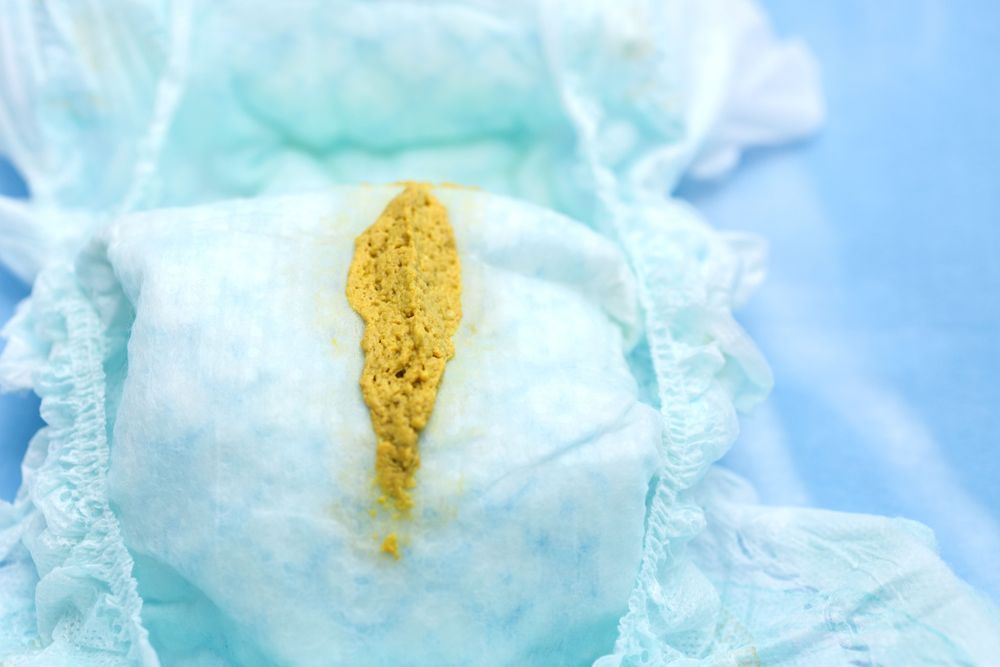Baby Poop - What Are Normal Stools for Breastfed Babies?
Although your baby’s stool may be a number of different colors and even textures, some stools serve as a warning sign.

This is not only a smelly subject but a health concern. Your baby’s poop can tell a lot about their health. When you look at your baby’s stool, there are several things to look at, for example, color, texture, smell, and frequency.
Different Types of Stools
1. Meconium Stool:
- Your newborn baby needs to have a bowel movement. The first bowel movement shows you that their digestive tract is busy maturing.
Color: Dark greenish, almost black color.
- Texture: Sticky.
- Smell: Odorless.
- Meconium is a baby’s first stool. You may wonder why a newborn baby would have a bowel movement when they haven’t been fed yet. Babies swallow the amniotic fluid in your womb. Thus, the Meconium consists of amniotic fluid, mucus, skin cells, and other substances ingested in the womb.
2. Transitional Baby Poop
- Color: Light greenish, mustard color.
- Texture: Less sticky.
- Smell: Mild smell.
- When your baby is between two to four days old, the stool will change in color and texture. This change indicates that your baby is starting to digest breast milk or formula, which is a sign that their digestive system is on track.
3. Normal Breastfed Infant Stool
- Babies who are breastfed have different stools from formula-fed babies.
- Color: Yellow or slight greenish color
- Texture: Creamy or mushy, even a bit runny with some seed-like spots/solids particles.
- Smell: Mild smell
- When it comes to an exclusively breastfed baby, you may find quite a few shades of normal. If you ate a lot of a particular color-rich food, like beet-root, your baby’s stool might have a slight red color to it. I remember the first time I drank too much of a particular blue cool drink. My little boy’s stool was a bluish color.
- Read more about normal breastfed infant stools here.

4. Low-Calorie Stool
- Color: Bright greenish color.
- Texture: Frothy, foamy.
- Smell: Mild smell.
- Your baby might have this change in his stool when he is taking in too much foremilk (low in calories) and not enough hindmilk. This is usually due to an oversupply of milk. Not to worry; you can correct a foremilk/hindmilk imbalance.
5. Formula-fed Infant Stool
- Color: Brownish color (from tan, yellow to green-brown)
- Texture: Pastey, peanut butter-like texture
- Smell: Mild to slight strong smell
- The difference between a breastfed and formula-fed baby’s stool is due to the different quantities of proteins in them. Both breast and formula milk contain whey protein (easily digested) and casein protein (slowly digested).
- In breast milk, there is more whey protein than in formula milk. This is why breast milk is more easily digested and results in more bowel movements.
- Formula milk contains more casein protein. Because the casein protein is digested slowly, it can result in fewer bowel movements and bigger volumes.

Tushbaby Hip Carrier
With its ergonomic design and comfortable waistband, Tushbaby provides optimal support for both you and your baby, allowing for bonding on the go. Say goodbye to shoulder and back pain from traditional carriers, as Tushbaby evenly distributes your baby's weight, relieving strain and promoting better posture.
6. Iron-fortified Baby Poop
- Color: Black or dark greenish.
- Texture: Pastey, peanut butter-like consistency.
- Smell: Mild to slight strong smell.
- The dark green-to-black color signifies too much Iron in your baby’s digestive system. Most formulas contain Iron, which is very important for a baby’s brain development. But you must have heard the saying that too much of anything is not usually a good thing. It’s the same scenario with Iron. If you are giving your baby an Iron supplement, it might be too much together with the Iron in your formula.

7. Solid Food Stools
- Please be advised that your baby’s digestive tract is only mature enough for solids by six months. Early introduction to solids might cause some digestive problems later on.
- Some healthcare professionals suggest solids at four months, but recent studies have proven it to cause many digestive issues, such as irritable bowel syndrome.
- Color: Anything from brown to green, even rosy pink in color.
- Texture: From pasty or creamy to thick and lumpy.
- Smell: Mild to strong odor.
- If you started your baby on solid food, you would notice an immediate change in your baby’s stool. It’s not only the color that changes but even the smell.
- Read more about the introduction of solid foods.
8. Stool with partially digested food
- Color: Rainbow colors (from brown to green or even yellow)
- Texture: Contains food particles.
- Smell: Strong smell.
- Every now and again, you may find pieces of undigested food in your baby’s stool. This is nothing to worry about. Some foods are only partially digested or may move through the digestive tract too fast to be entirely broken down.
- The big chunks may also indicate that your baby eats a lot of a specific food or that they don’t chew properly. Nothing can beat the smell of a half-digested grape.
9. Warning Stools
Although your baby’s stool may be several different colors and even textures, some stools serve as a warning sign. Please get in touch with a healthcare professional immediately if you identify any of the following.
- The reason for a white stool is the absence of bile. This lack of bile is usually due to liver or gallbladder problems. Learn more about white stools here.
- Black Stool: The black color is due to the digestion of blood. It looks dark and tarry like Meconium but firmer and not as sticky. This problem is known as melena.
- Bright red blood can show up in a baby’s stool for the following reasons: Milk protein allergy, Hemorrhoids (caused by constipation), and bacterial infection (blood accompanied by diarrhea).
- Blackish blood: If the blood in your baby’s stool seems black, blood has been digested. If the blood appears as little specks, it’s usually due to cracked and bleeding nipples. If this is the case, your baby is consuming your blood. This is not harmful. Read more about blood in breast milk here. If more than just specks of blackish blood is visible, it can be due to bleeding in a baby’s upper intestinal tract.
- Stool with mucus: If any other symptoms accompany this for longer than two days, it is a sign of allergy or infection. If there are no other symptoms, your little one might just be drooling more than usual. The excessive mucus in a baby’s saliva will often go undigested and end up in their stool. Read more about mucus stools.
- Diarrhea: When your breastfed infant produces very runny or watery stool without many solids, it is usually a sign of diarrhea. The color of the stool might range from yellow to brown or green. Diarrhea is caused by allergies or infections and can lead to dehydration, which can be fatal. If your baby has more than three diarrhea-like diapers or continues to show signs of diarrhea for more than 48 hours, you should contact your doctor immediately.
- Constipation: Your baby may produce very hard or even pebble-like stools. It can be caused by sensitivity to milk proteins or certain formulas, the transition to solid food, or the lack of fluids in your baby’s diet. The lack of fluids might be caused by fever, illness, or fluid loss from too much heat (sweat). Exclusively breastfed babies do not need extra fluids but should be breastfed on demand. Before giving your breastfed baby any supplements, first read: Is my baby drinking enough? And, When is it okay to supplement? Suppose your baby has more than three constipated bowel movements or you notice any sign of blood in the stool. In that case, you must contact a healthcare professional, especially if your baby is younger than three months.
Frequency
How many stools are normal?
The answer will differ for each baby. Some babies will have a bowel movement after every meal, and others may have only one or two bowel movements per week.
The texture or consistency is more important than the frequency of your baby’s bowel movements. If your baby’s stool is relatively soft, it’s entirely normal.
Exclusively breastfed newborns often have a bowel movement after every feed (around 6 to 10 times per day). Don’t despair. After 3 to 6 weeks, they start having less frequent bowel movements.
Call Your Doctor if:
- You see bloody mucus in your baby’s stool.
- Your baby has a fever.
- Your baby is vomiting.
- Your baby refuses to eat.
- Your baby’s urine is darker in color (dehydration)
- Your baby seems limp and unresponsive (call 911)
